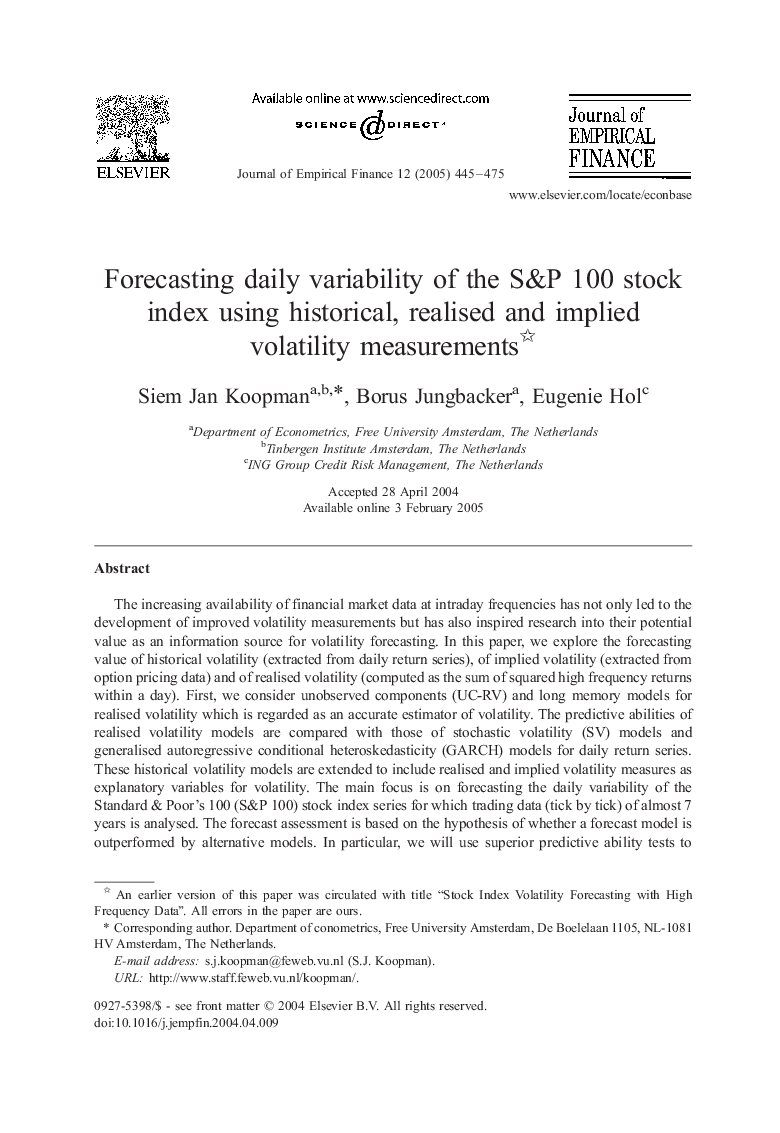| کد مقاله | کد نشریه | سال انتشار | مقاله انگلیسی | نسخه تمام متن |
|---|---|---|---|---|
| 10475168 | 929039 | 2005 | 31 صفحه PDF | دانلود رایگان |
عنوان انگلیسی مقاله ISI
Forecasting daily variability of the S&P 100 stock index using historical, realised and implied volatility measurements
دانلود مقاله + سفارش ترجمه
دانلود مقاله ISI انگلیسی
رایگان برای ایرانیان
کلمات کلیدی
موضوعات مرتبط
علوم انسانی و اجتماعی
اقتصاد، اقتصادسنجی و امور مالی
اقتصاد و اقتصادسنجی
پیش نمایش صفحه اول مقاله

چکیده انگلیسی
The increasing availability of financial market data at intraday frequencies has not only led to the development of improved volatility measurements but has also inspired research into their potential value as an information source for volatility forecasting. In this paper, we explore the forecasting value of historical volatility (extracted from daily return series), of implied volatility (extracted from option pricing data) and of realised volatility (computed as the sum of squared high frequency returns within a day). First, we consider unobserved components (UC-RV) and long memory models for realised volatility which is regarded as an accurate estimator of volatility. The predictive abilities of realised volatility models are compared with those of stochastic volatility (SV) models and generalised autoregressive conditional heteroskedasticity (GARCH) models for daily return series. These historical volatility models are extended to include realised and implied volatility measures as explanatory variables for volatility. The main focus is on forecasting the daily variability of the Standard & Poor's 100 (S&P 100) stock index series for which trading data (tick by tick) of almost 7 years is analysed. The forecast assessment is based on the hypothesis of whether a forecast model is outperformed by alternative models. In particular, we will use superior predictive ability tests to investigate the relative forecast performances of some models. Since volatilities are not observed, realised volatility is taken as a proxy for actual volatility and is used for computing the forecast error. A stationary bootstrap procedure is required for computing the test statistic and its p-value. The empirical results show convincingly that realised volatility models produce far more accurate volatility forecasts compared to models based on daily returns. Long memory models seem to provide the most accurate forecasts.
ناشر
Database: Elsevier - ScienceDirect (ساینس دایرکت)
Journal: Journal of Empirical Finance - Volume 12, Issue 3, June 2005, Pages 445-475
Journal: Journal of Empirical Finance - Volume 12, Issue 3, June 2005, Pages 445-475
نویسندگان
Siem Jan Koopman, Borus Jungbacker, Eugenie Hol,